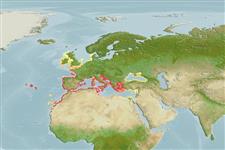>
Syngnathiformes (Pipefishes and seahorses) >
Syngnathidae (Pipefishes and seahorses) > Nerophinae
Etymology: Nerophis: Greek, neros, nearos = youhtfull appearance + Greek,ophis = serpent (Ref. 45335).
More on author: Rafinesque.
Environment: milieu / climate zone / depth range / distribution range
البيئة
بحري القاع. Subtropical
Eastern Atlantic: Portugal and the Azores. Mediterranean Sea: apparently most common in the Adriatic Sea and the western Mediterranean.
الحجم / وزن / العمر
Maturity: Lm ? range ? - ? cm
Max length : 30.0 cm TL ذكر/ مختلط الجنس; (Ref. 6733)
Occurs in coastal waters (Ref. 6733). Ovoviviparous (Ref. 205). The male carries the eggs in a brood pouch which is found under the tail (Ref. 205).
Life cycle and mating behavior
النضج | التكاثر | وضع البيض | بيض | الخصوبة | Larvae
Male carries the eggs in a brood pouch (Ref. 205).
Dawson, C.E., 1986. Syngnathidae. p. 628-639. In P.J.P. Whitehead, M.-L. Bauchot, J.-C. Hureau, J. Nielsen and E. Tortonese (eds.) Fishes of the North-eastern Atlantic and the Mediterranean. Volume 2. Unesco, Paris. (Ref. 6733)
IUCN Red List Status (Ref. 130435: Version 2024-1)
استخدامات بشرية
أدوات
تقارير خاصة
Download XML
مصادر علي الأنترنت
Estimates based on models
Preferred temperature (Ref.
123201): 15.6 - 20.3, mean 18.8 °C (based on 535 cells).
Phylogenetic diversity index (Ref.
82804): PD
50 = 0.6250 [Uniqueness, from 0.5 = low to 2.0 = high].
Bayesian length-weight: a=0.00093 (0.00036 - 0.00242), b=3.05 (2.83 - 3.27), in cm total length, based on LWR estimates for this (Sub)family-body shape (Ref.
93245).
مستوى غذائي (Ref.
69278): 3.4 ±0.45 se; based on food items.
المرونه (Ref.
120179): عالي, الحد الزمني الأدني لتضاعف عدد أفراد المجتمع أقل من 15 شهر (Preliminary K or Fecundity.).
Fishing Vulnerability (Ref.
59153): Low vulnerability (20 of 100).
Nutrients (Ref.
124155): Calcium = 85.2 [19.3, 280.4] mg/100g; Iron = 1.41 [0.54, 4.83] mg/100g; Protein = 3.37 [0.00, 7.05] %; Omega3 = 0.242 [0.104, 0.547] g/100g; Selenium = 16.1 [3.0, 47.3] μg/100g; VitaminA = 19 [6, 59] μg/100g; Zinc = 0.803 [0.409, 1.625] mg/100g (wet weight);
